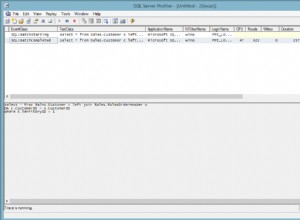आपको GROUP BY id की आवश्यकता है , और "एक से अधिक ऑर्डर" की शर्त एक HAVING . में जाती है खंड (क्योंकि यह प्रत्येक समूह पर एक बाधा है, इनपुट डेटा में प्रत्येक व्यक्तिगत पंक्ति पर नहीं)। एकत्रीकरण LISTAGG . के साथ किया जाता है ।
with
test_data ( id, product, code ) as (
select 1, 'Apple' , 145 from dual union all
select 1, 'Grapes', 146 from dual union all
select 2, 'Orange', 147 from dual union all
select 2, 'Apple' , 145 from dual union all
select 2, 'Plum' , 148 from dual union all
select 3, 'Grapes', 146 from dual union all
select 3, 'Orange', 147 from dual union all
select 4, 'Grapes', 146 from dual union all
select 5, 'Orange', 147 from dual
)
-- End of test data (not part of the solution). Query begins below this line.
select id, listagg(code, ' | ') within group (order by id) as codes
from test_data
group by id
having count(*) > 1
;
ID CODE
-- ---------------
1 145 | 146
2 145 | 147 | 148
3 146 | 147
हालांकि, Oracle 10 में आपके पास LISTAGG() . नहीं है . Oracle 11.2 से पहले, समान परिणाम प्राप्त करने का एक सामान्य तरीका पदानुक्रमित प्रश्नों का उपयोग करना था, कुछ इस तरह:
select id, ltrim(sys_connect_by_path(code, ' | '), ' | ') as codes
from (
select id, code,
row_number() over (partition by id order by code) as rn
from test_data
)
where connect_by_isleaf = 1 and level > 1
connect by rn = prior rn + 1
and prior id = id
and prior sys_guid() is not null
start with rn = 1
;
संपादित :
यदि एक ही आईडी के लिए दोहराए गए कोड को पहले "विशिष्ट" करने की आवश्यकता है, तो - दूसरे समाधान का उपयोग करके - निम्न परिवर्तनों की आवश्यकता है, दोनों अंतरतम उपश्रेणी में:
-
बदलें
SELECT ID, CODE, ...करने के लिएSELECTDISTINCTID, CODE, ... -
बदलें
ROW_NUMBER()करने के लिएDENSE_RANK()




